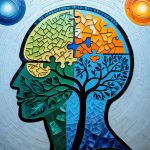Cognitive Behavioural Therapy (CBT) is a very well-researched therapy approach, and most psychologists in Australia are trained to deliver CBT to their clients.
Table of Contents
CBT works objectively
The reason we know CBT works is because we can measure the effect, or effectiveness of it, by comparing how people feel and function before and after therapy. And CBT works really well! A recent study of CBT showed it has an average effect size of 0.75 which is considered substantial, but a bit out of context, so let’s compare it to something we all know. If you have ever taken a painkiller for anything, you know they are rather effective – and they are, painkillers have an effect size around 0.32.
CBT helps you more with your mental health than a painkiller helps you with your headache, this is how effective it is!
Subjectively good as well
Over 90% of people receiving CBT feel, regardless of the mental health challenges they had, that their symptoms improve after treatment. Unfortunately, there are always cases who do not benefit from treatment, may it be psychological or medical.
CBT Works Really well for Depressive Symptoms
While the average effect size of 0.75 is impressive, it’s even better for depressive symptoms. It’s important to note that depressive symptoms, like feeling down, unmotivated, having no energy, and getting stuck with negative thoughts, are not a diagnosis, just a collection of symptoms that are typical to depressive disorders, such as Major Depressive Disorder or Persistent Depressive Disorder.
The study revealed a large effect size of 0.95 when treating clients for depressive symptoms, which is remarkable.
Recovery or Improvement?
Recovery rates depend on a specific diagnosis, specifically, if a client meets the criteria for a mental disorder before, and does not meet after the treatment, regardless of whether their symptoms improved.
While measuring recovery rates is meaningful, most clients who see a psychologist care more about how they feel, rather than diagnostic labels. In simple terms, for you, improvement is more important than a technical recovery.
Recovery is about labels, not just feeling better
In this sense, the rate of full recovery for CBT varies depending on the diagnosis. Some diagnostic groups, like those with specific phobias, had higher recovery rates than others, such as those with Borderline Personality Disorder (BPD). Recovery rates are typically in the 30-70% range for CBT therapy.
Comorbidity Influences Outcomes
Comorbidity, as in, the number of co-occurring mental health disorders, significantly influences treatment outcomes. Clients with more than one diagnosis tend to show slightly smaller improvements in symptoms compared to those with a single diagnosis.
This is likely because the treatment is less structured if two overlapping problems are being targeted at once. For instance, CBT therapy works well for both depressive symptoms and Obsessive-Compulsive Disorder (OCD) but the treatment structure is different. Therefore, if a client struggles with both at the same, the structure and delivery of therapy are not as clean as working on a single challenge.
Where CBT is the Most Effective
CBT is particularly helpful for certain conditions. Specific phobias show the highest improvement rate, with 39.1% of participants expressing that their mental health very much improved. Substance use disorders and bipolar disorder followed closely, both at 38.6%. Conditions like generalised anxiety disorder (35.6%), obsessive-compulsive disorder (35.8%), and interestingly schizophrenia (32.7%) also report very much improved functioning, reinforcing CBT’s versatility in managing both emotional and cognitive symptoms.
Even in diagnoses with slightly lower response rates, CBT still provides meaningful improvements. Adjustment disorders (32%) and major depressive disorder (31.1%) showed that nearly one in three individuals experienced notable improvement. While effectiveness varies, the consistency across conditions, all hovering around 30% or higher, suggests CBT remains a reliable option for many people seeking structured, skills-based therapy.
Is Newer Always Better?
When thinking about CBT, some people think about it as an “old technology” that has been superseded by newer, cooler things. The analogy, however, is not that accurate as our minds and bodies haven’t changed much, if at all, since the invention of mental health treatments. When research understands an area better, it is typically added to the CBT toolkit, such as helping people after traumatic events with Trauma-focused Cognitive Behavioural Therapy (TF-CBT), or helping people with sleep problems with Cognitive Behavioural Therapy for Insomnia (CBT-I).
While there are other approaches to treating mental health problems, we may not have data to suggest that they are better than CBT. Just like the way we treat broken bone today is the same as it was during Egyptian times: support it so it does not move until the bone has time to heal.
Do you or your loved one need some support? We are here to help!
Please note that this blog post by Personal Psychology, psychologists in North Sydney, and is not intended to provide professional advice. If you or someone you know is experiencing mental health difficulties, it is important to seek help from a qualified healthcare professional.




